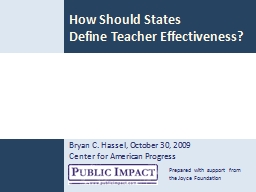As evidence continues to pile up about the central importance of effective teaching, states nationwide are rethinking how they define and measure the effects individual teachers have on educational outcomes.
In this slide deck, Public Impact® sets out some guiding principles for states entering this design process, including:
- defining a teacher’s “effect” as the product of her level of effectiveness and her reach: the number of students she affects;
- defining teacher effectiveness based on student learning outcomes and behaviors linked to outcomes;
- using rigorous research about top teachers – not focus groups or expert opinion – to determine what behaviors to include in the definition; and
- examining deeper competencies – such as achievement orientation – not just more easily observable teacher behaviors.
States can play a central role in driving strong measures of teacher effectiveness by requiring measures that truly differentiate performers; shining a bright light on how different districts and schools are doing on improving effectiveness; creating a state-mandated “floor” for teacher evaluation systems; and driving an ongoing effort to improve the definition and measurement of teacher effectiveness.
This presentation was prepared with the support of The Joyce Foundation as part of a larger project examining ways to reform teacher evaluation, tenure and other systems to achieve more “selective retention.”

